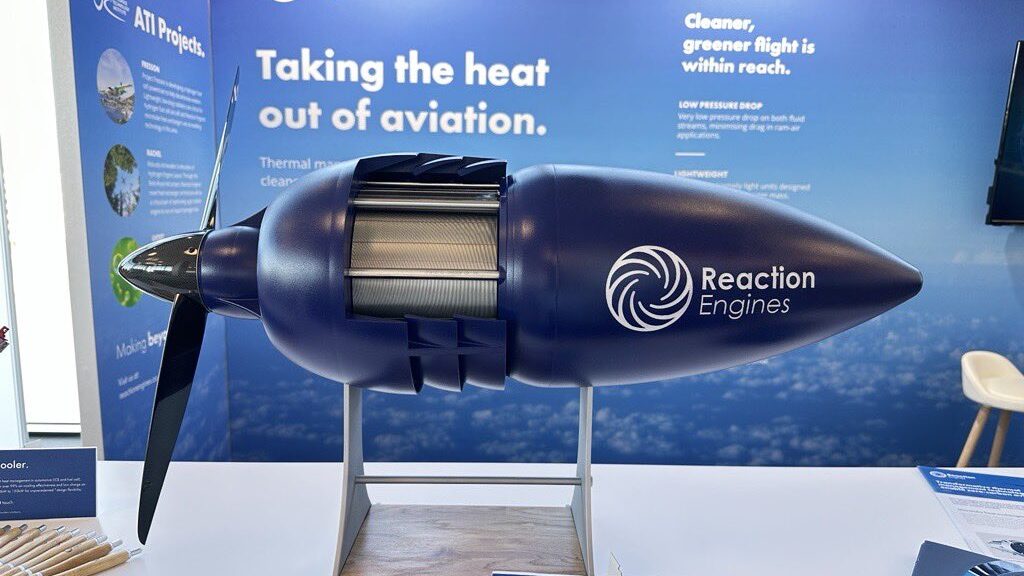UK firm Reaction Engines specialises in high speed propulsion and cooling technologies, but collapsed today after failing to secure a rescue deal (Reaction Engines)
BELFAST — The UK Ministry of Defence said it will continue to “closely monitor all our supply chains” as it reels from the collapse of Reaction Engines, the high speed propulsion manufacturer and industry lead on London’s quest to develop a reusable Mach 5 and beyond aircraft under the Hypersonic Air Vehicle Experimental (HVX) program.
The aerospace company, best known for its cutting-edge cooling technology and Synergetic Air Breathing Rocket Engine (SABRE), is also part of the £1 billion ($1.3 billion) Hypersonic Technologies & Capability Development Framework (HTCDF) effort to build and deliver a first UK hypersonic missile, but was plunged into administration today after failing to secure a financial rescue deal, according to Sky News. The company reportedly conducted weeks of talks with potential buyers, including an unsuccessful attempt to win over £20 million from the United Arab Emirate’s Strategic Development Fund (SDF), the investment agency of the UAE’s Tawazun Council.
Sky News noted that accountancy firm PricewaterhouseCoopers (PwC) had officially taken on Reaction administration duties today. PwC did not immedately respond to a requst for comment from Breaking Defense, nor did the UAE’s SDF. A spokesperson for Reaction declined to comment.
Analysts told Breaking Defense it remains to be seen what impact Reaction’s troubles will have on hypersonic programs, but there are few who could replace the company’s share of the hypersonic work. The UK MoD only told Breaking Defense in a statement on Wednesday, prior to the official news, that the MoD has a “long running relationship with Reaction Engines Ltd and closely monitor[s] all our supply chains to ensure the continued delivery of key capabilities, including research and development.”
Reaction, Rolls-Royce, the Royal Air Force’s Rapid Capabilities Office (RCO), the UK Government’s Defence Science and Technology Laboratory (Dstl) and the UK’s National Security Strategic Investment Fund (NSSIF) are jointly involved in HVX, which has been designed to “rapidly develop critical high-Mach/hypersonic technologies, including novel air-breathing propulsion architectures, innovative thermal management systems and advanced vehicle concepts,” according to Rolls-Royce.
SABRE and patented cooling technologies are critical parts of HVX. Progress on the effort includes launch of a full-scale experimental engine test campaign, partners carrying out design work on hypersonic vehicle concepts and the unveiling of Concept V — a single engine hypersonic concept vehicle.
Regarding the separate hypersonic framework effort HTCDF, Reaction was picked by the UK in May, as one of 90 small and large organizations from industry and academia, eligible to bid for contracts in support of developing indigenous hypersonic missile capabilities.
A total of eight hypersonic technology lots for the project cover: design and integration, modelling and testing, airframe and power generation, low Technical Readiness Level (TRL) concepts, a lethality package (including warhead and fuse), propulsion, on board computing, and seekers.
London has settled on a three-step strategy of buy, collaborate and develop to build out hypersonic missile capabilities, which also focus on potentially acquiring a Hypersonic Glide Vehicle (HGV) as part of AUKUS Pillar II.
Like all other major projects, the long term future of HVX and HTCDF remain on hold until the UK’s Strategic Defence Review (SDR) reports in mid-2025, but Reaction’s collapse could have a troubling impact on both high profile projects, analysts said.
William Freer, research fellow at the Council on Geostrategy, a British think tank, told Breaking Defense on Wednesday following early reports of Reaction’s then-potential downfall that “going into Administration would certainly cause headaches for the HVX programme, but it is difficult to say exactly what the direct impact would be.” He noted the “outcome is highly dependent on exactly who is brought in for administration and how they decide to carry out the process.”
Christie Maddock, an associate professor at the Aerospace Centre of Excellence at the University of Strathclyde in Scotland, questioned how UK industry could replace Reaction.
“The biggest impact will be that the UK loses its its leadership in this field [cooling technology], and I don’t know that anybody at the moment has enough momentum or enough investment to be able to pick it up again,” she noted.
The financial difficulties that led to Reaction’s demise were not altogether new. Asked about company challenges on the Aviation Extended podcast last year, Mark Thomas, Reaction Engines CEO said, “Historically, it’s been money raising … having to continually, on an almost annual basis, raise money for the business to fund the projects and the demonstrations and the trials. That’s becoming less of a concern, but now it’s shifted more into the need to penetrate the markets, generate revenue, to pour that back into the business to be self sufficient.”











